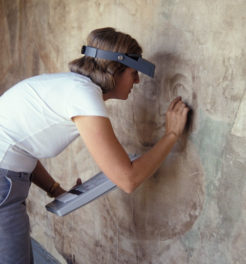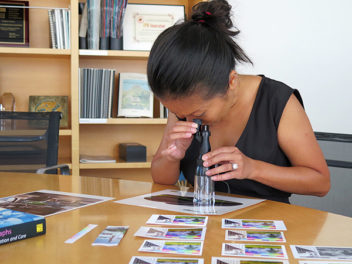
Annie Valdes in the laboratory running analyses with the Microfading Tester.
For 25 years, the Getty Foundation’s Multicultural Undergraduate Internship program has placed students from traditionally underrepresented backgrounds into paid, fulltime positions at local arts institutions, including the Getty Center and Getty Villa, providing an opportunity for direct exposure to arts and culture work in Southern California. In the process, the program develops a diverse, culturally inclusive network of professionals in the arts.
At the Getty Center, the Conservation Institute hosted two interns this summer. In the final weeks of their internship, they wrote about their work and how it fits into their education and plans for the future.
Using Scientific Data to Preserve Art
Annie Valdes, Humboldt State University
It is no surprise to me that Leonardo da Vinci was both an artist and a scientist. To quote the Renaissance man, “Art is the queen of all sciences communicating knowledge to all the generations of the world.” Art has the power of interpretation and dissemination, using data to create a visual dialogue that transcends language. The hand of the artist transforms the laws of physics, chemistry, and mathematics into painting, sculpture, and architecture. At the Conservation Institute, scientists are flipping this concept on its head, using data to understand works of art.
The quintessential Libra, I often have trouble making decisions. Please do not ask me what I want to eat for dinner because I have no idea—it all sounds delicious. My academic career has not been spared my indecision; I have spent the past few years studying art history, studio art, and chemistry. To me, these subjects provide different but complementary insights into individual objects. At the Getty, I am encouraged to combine these disciplines. In my internship, I share a lab with scientists whose training spans chemistry, physics, environmental science, conservation science, and art history. Together, they utilize their individual expertise to shine light on some of the less communicable features of the artwork.

Annie’s work space. A Microfading Tester deliberately fades colors in order to measure how quickly they deteriorate.
As a Multicultural Undergraduate Intern, I work with instruments and resources that are usually reserved for conservators and conservation scientists. Every day, I use scientific and art-historical parlance interchangeably. With the guidance of my supervisors, I have learned how to put data into context. Information lost to history re-emerges in the form of a spectra. I know it sounds nerdy, but it is in fact very exciting.
I work independently in the lab, running analyses with the Microfading Tester (MFT) while sifting through existing MFT data for an in-progress database. The MFT is an instrument that instigates the fading of a color while simultaneously measuring the rate at which it is fading, providing information on the light sensitivity of an art object. For the database, I am inputting MFT data collected at the Conservation Institute for numerous objects that will allow one to look for trends across a broad dataset. We hope that this will eventually guide conservation practices across cultural heritage institutions. With every entry into the database, I am helping to preserve a piece of art.
Forging Personal Connections through Cultural Heritage
Summer Farah, UC Berkeley
I began college as an English major and later found art history, both disciplines that investigate what it means to tell stories. Storytelling has always been a staple of my identity. I love the opportunity to examine narratives, consider why we enjoy or dislike them, and discuss how they affect society. It was difficult to relate my interest in culturally-informed storytelling to my work at school. As a first generation Palestinian-American, I looked through course catalogues trying to figure out how I could fit the Middle East into my degree, or if Arab Americans were included in the literary canon I encountered in class. The answer: no. Out of frustration, I sought out institutions that would help me study my roots. My opportunity came through the Getty Conservation Institute’s MOSAIKON project, which aims to conserve archaeological mosaics in the Middle East and North Africa.
Though a lot of interns in the program know they want to eventually work in museums, I’m still trying to figure out what I want to do. I know it will involve storytelling in some form—whether it is visual, literary, or something else. And I knew that I wanted to find people that were interested in my homeland with its wealth of literature, art, and culture, people that valued its legacy outside of violence.

Summer Farah at her desk in the Getty Conservation Institute, with materials from the MOSAIKON initiative.
Most of my work on the MOSAIKON project has involved a computer: I have catalogued project images and added metadata to those images, researched bibliographies, and updated the MOSAIKON contact database to correct and fill in the missing information of people who have been involved in or connected to the project. While the last part seems mundane on paper, it has actually been the most personally fulfilling. Beyond just googling professors and conservators to find their current e-mails and phone numbers, working on the database pointed me to the research and work of over a thousand people associated with this project, which in turn led me to a body of Middle Eastern scholarship. As I filled in the blanks in the database, I found out about new and exciting work, like the Hebron Rehabilitation Committee, articles written on Palestinian architecture, and the magazine Reorient, a publication that focuses on Middle Eastern and North African arts and culture. Access to the MOSAIKON database introduced me to a thousand people who were studying precisely what was missing from my academic training, people from whom I can potentially learn, people who could help me figure out the story I want to tell, figure out the fragments of my history that was missing. This internship is not just for folks aiming for PhDs in art history and curatorial positions—I sought personal fulfillment with my Getty opportunity, and it has pointed me in the right direction for my future.
More information on the Multicultural Undergraduate Internship program, including eligibility and how to apply, is available on the Getty Foundation website.




Comments on this post are now closed.